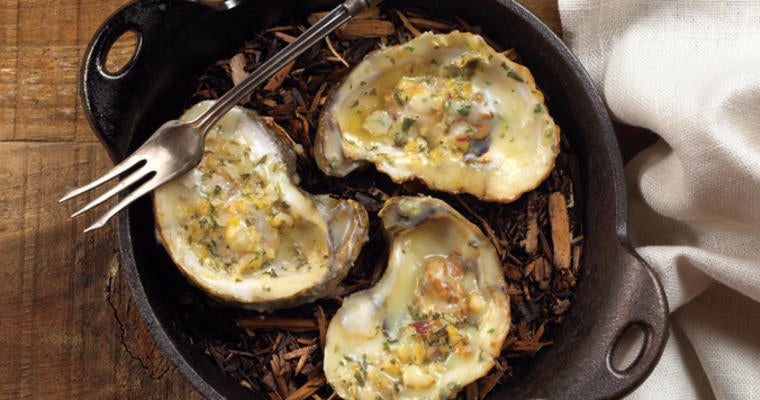More casual and upscale-casual restaurants are adding hot-oyster dishes to their menu.
Attention, seafood lovers: Oysters are a hot opportunity.
Chefs are getting more creative with oysters. They’re full of flavour, oysters are a great source of protein and they add cachet and indulgence to menus.
And it’s not just oysters’ popularity that’s heating up. Serving oysters hot is one of today’s leading-edge seafood trends.
“More casual and upscale-casual restaurants are adding hot-oyster dishes to their menu and giving them a wide variety of new eating and flavour treatments,” says Gordon Food Service Corporate Consulting Chef Gerry Ludwig, CEC.
Many factors account for expanded opportunities for menuing oysters:
- Typically seen as a luxury item or treat, oysters aren’t easy to prepare at home.
- Oysters are ideally suited for sharing-plates and appetizers.
- Oysters are versatile and perfect for cross-utilization in many applications.
- While not low in cost, oysters can still be menued at an attractive price point.
Diving in
Expanded fresh and frozen options make it easy to procure, store and handle oysters safely.
For fresh oysters, the old saying about eating oysters only in months with an ‘r’ in them isn’t true anymore. Thanks to improvements in cultivation, pasteurization and processing, oysters are always available to operators.
“Operators can purchase oysters in the half shell that have been shucked live and immediately blast frozen,” Ludwig notes. “They’re plump and sit nicely in the shell.”
Even better, hot oysters don’t require complicated, labour-intensive preparation.
“It’s more of a simple layering of flavourful ingredients,” Ludwig explains. “Cook oysters until they’re just warm. You don’t want to dry them out.”
The hottest hot-oyster preparation methods
A staple of coastal regions, oysters have swum in chowders, stews and ragus. Whether battered and fried, loaded into pies, stuffings and dips, or used to top off bruschetta, hot oysters have, in one form or another, long been a hot commodity. New ways to serve them hot are expanding ways to satisfy oyster lovers while adding depth to seafood menus.
“In our external research,” Ludwig says, “we see all sorts of examples for expanding the flavour possibilities via a combination of more aggressive cooking methods as well as creative sauces and toppings.”
Four preparation methods using oysters on the half shell are standouts:
Wood-grilling. Top raw oysters with melted flavoured butter or oil—or liqueur—and char-grill just long enough for the heat to permeate the shell.
Oven-roasting. Briefly bake oysters at a very high temperature in a convection oven, wood-fired pizza oven or regular oven. Top with a breadcrumb crust to keep oysters plump and juicy.
Pan-smoking. Add sawdust, wood chips, hay or straw to the bottom of a small cast-iron pan, top with oysters, and smoke briefly for a dish with a “smoked-in-the-serving-dish” presentation.
Pan-frying. Remove oysters from the half shell; reserving the shell.
Roll oysters in flour or breadcrumbs, pan-fry, then return to the shell for saucing, topping or garnishing. Choose pan-frying over deep-frying, Ludwig advises, for the sake of menu differentiation.
Sauces and toppings
Flavour options for hot oysters are practically limitless.
Sauces
- Aïoli or other mayonnaise-based sauces.
- Compound or flavoured butters prepared with aromatics (e.g., onion, shallots, garlic or herbs), wine or liqueur.
- Hollandaise-based sauces.
- Salsas and tomato sauces, such as marinara.
- Alfredo-based or other cream-based sauces.
- Rich Creole sauces.
Toppings
- Roasted or braised vegetables or vegetable relishes, e.g., tomato or onion jam, ratatouille, piperade, etc.
- Baba ghanoush or smooth hummus with a drizzle of olive oil or aïoli.
Liqueur-based flavorings
- Anise-based liqueurs—pastis (e.g., Ricard), ouzo or absinthe.
- Orange- or lemon-flavored liqueurs, e.g., Curaçao or Limoncello.
- Slightly sweeter almond- or hazelnut-flavored liqueurs, e.g., amaretto or Frangelico.
- Fortified wines⎯e.g., sherry and Madeira (apply them only just before roasting or grilling).
Crusts and crumbles.
Sprinkle these on oysters before roasting.
- Panko breadcrumbs.
- Dried toasted cornbread crumbs.
- Crushed or crumbled pretzels.
- Toasted quinoa.
- Shredded or grated Parmesan or Romano cheese.
- Crispy fried onions or fried shallots.
- Crumbled meat proteins⎯e.g., small bits of crunchy bacon, dry salami, sopressata, ground chorizo or sage pork breakfast sausage.










